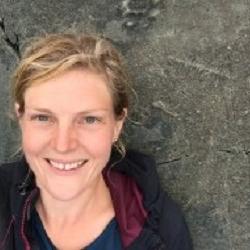My research investigates the role of ecological processes on evolution through deep-time, from the first animal communities of the Ediacaran to the present.
Research Area
There are two areas of my research: palaeontological research of the early animal communities of the Ediacaran and the community ecology of marine benthic communities.
Animals first appear in the fossil record during the Ediacaran time period (631-541 million years ago). It is during the Ediacaran that animals evolved some of their most important traits: most obviously large body-size but also tissue-differentiation, mobility, bilateral symmetry and ecosystem engineering (reef-building). The study of Ediacaran organisms is fraught with difficulties, because commonly-used morphological approaches have only limited use due to the unique anatomies of Ediacaran organisms. Fortunately, the preservation of Ediacaran fossils is exceptional, with communities comprised of thousands of sessile organisms preserved where they lived under a layer of volcanic ash. Therefore, the position of the fossil on the rock surface encapsulates their entire life history: how they reproduced and how they interacted with each other and their environment. Over the last ten years, mathematical ecological approaches have demonstrated how previously elusive biological details can be extracted from the Ediacaran fossil record. As such, ecological statistics provides a novel approach for investigating fundamental issues in early animal evolution.
A key area of my research is on the dynamics of modern marine benthic community dynamics, identifying the key ecological interactions that drive benthic biodiversity, and understanding how these drivers may change as ecosystems are perturbed both biologically and environmentally. Key to my approach is looking beyond interactions just between pairs of taxa, but understanding how the community interacts as a whole, and how changes cascade through the ecosystem and effect different organisms in different ways. Currently, I am working to understand the community dynamics of Antarctic, deep-sea and tropical benthic communities. By reconstructing communities throughout the maturation processes, my group and I aim to understand how ecological interactions differ throughout community development and thus elucidate how such dynamics contribute to community structure, resilience and stability.
Project Interests
Within my palaeontological interests, I am interested in co-developing projects with students on two topics. First, for students with an Earth Science/Biology background, I would like to co-develop a project to investigate how different post fossilization processes impact our understanding of Ediacaran community ecology. Second, for students with strong computational/quantitative interests, we could co-develop a project using dynamic models of Ediacaran eco-evolutionary dynamics to investigate how difference processes influence Ediacaran evolution.
For students with a marine ecology/biology background, I am interested in co-developing projects focussed on the community dynamics on either Antarctic, deep-sea or tropical coral and sponge communities. These projects would involve fieldwork (tropical) or video databases such as the AWI Pangea (Antarctica) to collect video data, which would then be used to construct 3D digital models from which community analyses can performed to investigate the key drivers that shape these benthic communities, and how they may change in the future.

